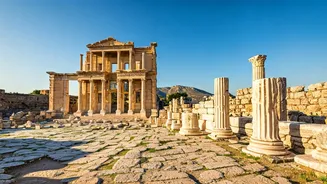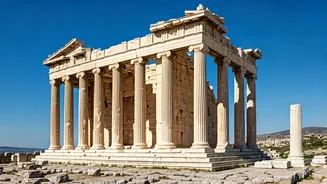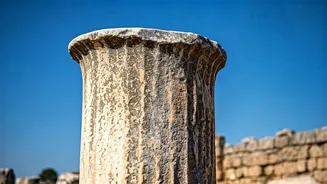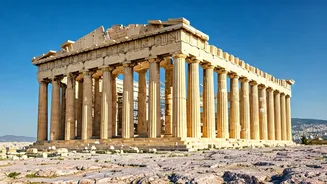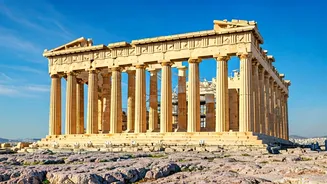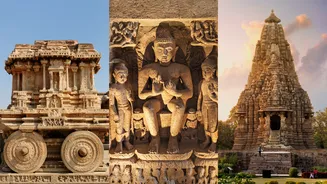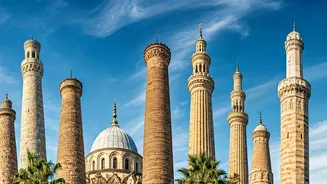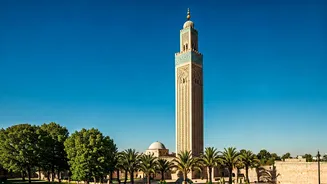Acropolis of Athens
The Acropolis, perched atop a rocky outcrop overlooking Athens, is arguably the most famous ancient ruin in Greece. Its iconic Parthenon, dedicated to the goddess
Athena, stands as a testament to classical architecture and the pinnacle of Athenian power during its Golden Age. The Propylaea, the monumental gateway, and the Erechtheion, with its unique Caryatids, also showcase the architectural prowess of the ancient Greeks. Visiting the Acropolis isn't just a sightseeing trip; it's an immersion into a vibrant era, offering a profound appreciation for art, philosophy, and democracy's origins. Each structure tells a story, from the intricate friezes to the very stones laid by master craftsmen. Exploring this site provides a tangible link to a world that shaped Western civilization, making it a must-see for anyone interested in history, architecture, or the legacy of ancient Greece.
Delphi's Sacred Site
Delphi, the 'Navel of the World,' was a sacred sanctuary and the home of the Oracle, where ancient Greeks sought divine guidance. Nestled on the slopes of Mount Parnassus, the ruins include the Temple of Apollo, the theater, and the stadium. Visitors can trace the path of ancient pilgrims, imagining the rituals and ceremonies that took place. Delphi's strategic importance and spiritual significance made it a focal point for ancient Greek life. The archaeological site showcases well-preserved structures and artifacts, offering a glimpse into the religious beliefs and practices of the time. The Temple of Apollo stands out, marking where the Pythia, the priestess of Apollo, delivered prophecies. The theater provides insight into how the ancient Greeks enjoyed entertainment. The stadium is a testament to athletic events. Exploring Delphi helps uncover the ancient world's religious and cultural heart, revealing the influence of gods and the importance of spirituality in everyday life. Its beauty and historical weight make it a compelling destination.
Ancient Olympia's Games
Olympia, the birthplace of the Olympic Games, holds a unique place in history. The ruins of the Temple of Zeus, the stadium, and various training facilities convey the significance of athletic competition. This sanctuary hosted the Panhellenic Games, a celebration of athletic prowess and religious worship. The ancient Greeks viewed the games as a means to honor Zeus and promote peace among city-states. Visiting Olympia is like stepping back in time, imagining the excitement and competition of the games. Explore the athletic arenas, the temples, and the remains of the gymnasium, which offered a look into how athletes prepared. The site's museum houses significant artifacts. It helps to understand the dedication, training, and cultural importance that these events had. The Olympic Games represented the ideals of strength, skill, and unity and have influenced the modern world. Exploring Olympia offers an insightful and inspiring experience.
Knossos Palace, Crete
Knossos, in Crete, is the most important Bronze Age archaeological site in the country, showcasing the sophisticated Minoan civilization. The Palace of Knossos, with its intricate architecture, vibrant frescoes, and labyrinthine layout, stands as a testament to Minoan art and culture. The Minoans, known for their advanced society and naval power, flourished in Crete. The palace complex offers a deep dive into the Minoan way of life. It provides insights into their social structure, religious beliefs, and artistic expressions. Visitors can explore well-preserved structures, including the throne room and the grand staircase, and imagine the palace's bustling life. The vibrant frescoes illustrate scenes of daily life, ceremonies, and wildlife, capturing the Minoans' artistic flair. Knossos showcases the ingenuity and artistry of the Minoans, who were precursors to Classical Greece. It invites visitors to appreciate their remarkable civilization, making it a key destination for anyone keen on ancient Mediterranean history.
Ancient Agora of Athens
The Ancient Agora of Athens was the center of public life, serving as a marketplace, a meeting place, and the heart of Athenian democracy. It held the Stoa of Attalos, which acted as a shopping center. It also hosted political gatherings and philosophical discussions. This vibrant area reveals how ancient Athenians conducted their daily lives. The ruins include temples, administrative buildings, and shops, offering a peek into the commercial, political, and social activities of ancient Athens. The Agora was where citizens debated, voted, and made decisions about their city. Exploring this site provides insight into the birth of democracy and the role of civic engagement. The Stoa of Attalos showcases the sophistication of Athenian architecture. The remains of the temples and other public buildings reveal a culture where civic responsibility was essential. A walk through the Agora lets one experience the core of the Athenian world.
Ephesus, Turkey
Although technically in modern-day Turkey, Ephesus was a significant Greek city and one of the largest and best-preserved ancient cities in the Mediterranean. It features the Library of Celsus, the Temple of Artemis, and a large theater. The city was a major center of commerce, culture, and religion, and its ruins offer a spectacular look into the Hellenistic and Roman periods. The Library of Celsus, with its magnificent facade, stands as a symbol of knowledge. The Temple of Artemis, though only fragments remain, was one of the Seven Wonders of the Ancient World. The vast theater once held thousands of spectators. Ephesus's well-preserved streets, houses, and public buildings show the city's urban planning and architecture. Walking through Ephesus reveals the complex society, trade, and cultural exchanges that characterized the ancient Mediterranean world. It demonstrates the lasting impact of Hellenistic and Roman civilizations, making it a highlight for any visitor.
Meteora Monasteries
The Meteora monasteries, perched atop towering rock pillars in Thessaly, are a blend of nature and human endeavor. These UNESCO World Heritage sites combine religious history and stunning landscapes. The monasteries, built by monks seeking spiritual isolation, offer breathtaking views and a unique perspective on Byzantine architecture. Originally built for solitude and contemplation, the monasteries are a testament to the dedication and resilience of their inhabitants. Visitors can explore the interiors, admire the frescoes, and learn about the monastic life. The monasteries' location provides a sense of wonder. The views are astonishing. The Meteora offers both a cultural and spiritual experience. It is a striking representation of faith and human ingenuity, which have combined to create an atmosphere like no other.
Ancient Corinth
Ancient Corinth, a city-state with strategic importance, was a significant center for trade, culture, and warfare. The ruins include the Temple of Apollo, the Acrocorinth, and the marketplace. Its location near the Corinthian Isthmus allowed Corinth to control crucial trade routes, making it a wealthy and influential city. Corinth was known for its art, architecture, and luxury. Exploring Ancient Corinth gives insight into its importance as a commercial and cultural center. The Temple of Apollo represents Corinthian religious traditions. The Acrocorinth, a fortified citadel, highlights the city's strategic importance. The marketplace gives a glimpse of everyday life. The site's ruins paint a vivid image of ancient Greek life. The history of Corinth is a testament to its pivotal role in the development of Greek civilization, making it a significant destination for history enthusiasts.
